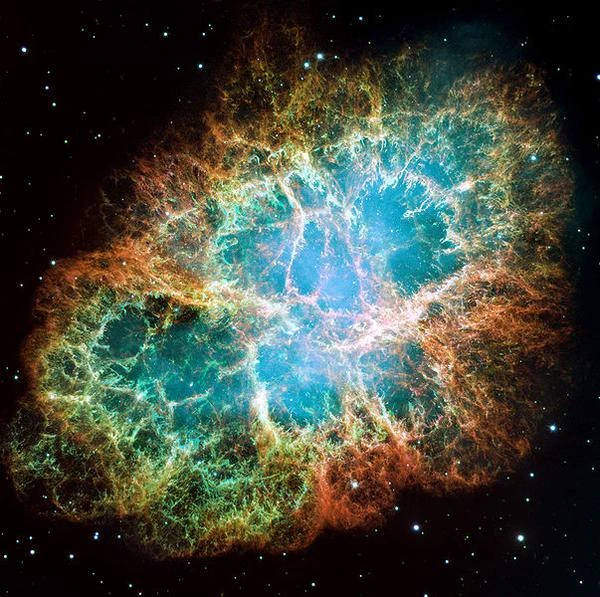
Image description: The Crab Nebula contains interstellar dust grains composed of primordial minerals, such as silicates and carbides, formed in the remnants of the supernova that enriched space with heavy elements. These minerals, among the first solids in the universe, testify to the early stages of complex matter formation and are the precursors to materials found in meteorites and on Earth.
A mineral is a natural, solid, inorganic substance that possesses a precise chemical composition and an ordered crystal atomic structure. For example, the chemical formula for quartz is SiO2, indicating a composition of silicon and oxygen in fixed proportions. Do not confuse rocks with minerals. A mineral is a pure substance, while a rock is an aggregate composed of several minerals. For instance, granite is a rock formed from quartz (SiO2), feldspar (KAlSi3O8), and mica (KAl2(Si3Al)O10(OH,F)2), each being a distinct mineral.
After the Big Bang, the primordial Universe was mainly composed of hydrogen and helium, with trace amounts of lithium. These light elements formed during the universe's early moments in a process called primordial nucleosynthesis.
It is not with these first light elements that the first crystals will form. In other words, primordial nucleosynthesis does not explain the formation of the first minerals.
For minerals to form, heavier elements are necessary (carbon, oxygen, aluminum, silicon, iron, etc.).
Heavier elements were produced in the cores of stars through nuclear fusion reactions. When a star reaches the end of its life, particularly in supernova explosions, it releases into space the heavy elements it has produced. However, the minerals formed in these ejecta are quite simple and not diverse, as the extreme physicochemical conditions do not allow for the formation of many stable minerals.
The primordial minerals present in stellar ejecta are the first solids to condense from the hot, ionized gases expelled during the death of stars. These minerals form under extreme temperature and pressure conditions, and their composition is limited by the chemical elements produced and dispersed in interstellar space.
Simple silicate grains such as olivines (Mg2SiO4) and pyroxenes (MgSiO3), as well as carbon-rich compounds (like diamonds and carbides), can condense in these ejecta. The majority of "minerals" in stellar ejecta are interstellar dust, small particles of carbon, silicon, iron, and other elements, often amorphous (without ordered crystal structure) or poorly crystallized.
After a stellar explosion, a few types of primordial and simple solids form in stellar ejecta. The main types of minerals and solid elements observed in these environments are silicates, carbides, graphites, nanodiamonds, metal oxides, sulfides, metals, and alloys.
These primordial minerals found in stellar ejecta are relatively simple and represent the building blocks of solid matter in the interstellar medium. They form under specific temperature and pressure conditions and mainly depend on the chemical elements available, such as silicon, magnesium, iron, carbon, sulfur, and aluminum.
The number of stable primordial minerals is estimated to be only a small handful.
The simple and resilient primordial minerals, by aggregating, contributed to the formation of planets, on which more complex minerals are observed today.
Earth has an exceptionally varied mineralogy. More than 5,000 distinct minerals are found on Earth.
It is indeed stellar ejecta that provided the necessary building blocks for mineral formation, but terrestrial mineral diversity results from a long and complex geological and chemical evolution. The transition from a handful of primordial minerals to over 5,000 is the result of billions of years of chemical, geological, and biological evolution.
When Earth formed, intense internal heat led to the formation of magma, which, upon cooling, gave rise to the first igneous rocks, from which various minerals crystallized.
Over time, minerals underwent numerous reactions under changing environmental conditions, including metamorphism, sedimentation, and alteration due to biological processes. These transformations resulted in the emergence of a variety of new minerals and the significant diversification of existing minerals.
Today, we understand that the universe is composed of simple elements that condense to form the first minerals in stellar systems. These primordial minerals serve as the foundation for the immense diversity of materials observed today on Earth and throughout the universe. Understanding these processes allows us to gain insight into our planet's history, the evolution of matter, and the origins of life itself.